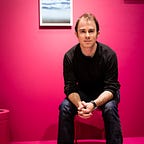Startup Dogma
This essay is the second in a series documenting lessons learned from my time at Electric Objects. Follow me on Medium to find out when the next essay is published.
Electric Objects was born out of a problem that I encountered and felt personally.
After this tweet, in subsequent conversations with friends, and in the early prototyping process, I found others like me who shared this need, who felt this problem deeply, and who were thrilled with the promised solution: a digital display that behaved like the paintings and photographs on our walls — that quietly and elegantly conveyed a digital art experience.
Building a product for myself had some advantages early on: I was the customer and so could follow my intuition through the early stages of product and brand development. The brand voice felt authentic because it was the voice of the founder. I was speaking to myself and people like me. Customer interviews happened around the dinner table and inside my head. Building a product for myself made a lot of early decisions easy.
But it had some drawbacks later on. It meant that my mission for the company and market was closely aligned with my personal vision for the product and how I wanted it to behave in my home, and in the homes of people I knew.
Looking back, I realize now that you can be dogmatic about what your product should be, or you can be dogmatic about who the product is for, but you can’t be dogmatic about both. The product development process requires flexibility around one, the other, or both.
This inflexibility may have served us well in the early days, but held us back later on.
“No Slide Shows”
Part of the my vision for Electric Objects was to build a computing platform that couldn’t demand my attention. I didn’t want yet another distraction in my home—another source of information overload. EO would be a quiet product, one that delivered value only over time, through the permanence and persistence of the art experience, not through the typical cycle of notification-usage-reward that dominates the rest of our connected lives.
When we launched on Kickstarter we promised “no slide shows.” It was good marketing copy, and it distinguished EO from a long history of negative associations with digital picture frames.
But as soon as the product landed in the homes of customers, the number one requests was for—you guessed it—slide shows! Customers wanted an easy way to rotate through a collection of art. To them, it was obvious that our product should take advantage of one of the key benefits of screen technology—that it can change programmatically.
I saw it as sacrilege, and resisted it for a long time, holding fast to the idea that customers only think they want slide shows, but that the feature would over time erode the core value of the product. I was convinced our customers were wrong, and I would rejoice in the 1 out of every 10 people who commended us for the lack of slide shows. This was our headphone jack moment.
It took the entire team lining up behind our customers to convince me to give it a try. The results were immediate — improvements in NPS, sales, and engagement, and I just as quickly realized that I had been wrong.
More Nonfat Milk, Please
The slide show feature debate is one example of many from our four years building EO. Debates ranged from editorial flexibility (“Do we showcase photography and classic art?”) to content flexibility (“Do we allow users to upload photos from their phones?”). Each time a customer demand challenged our dogma, we would struggle to figure out where to stand firm and where to compromise. We obsessed over who we were and what we stood for, and neglected our customers in the process.
Looking back, I realize the issue stems from a conflation of mission and product. When your mission so narrowly dictates what your product is and how it should be experienced in the world, you constrain your ability to follow your customers to market fit.
I found a great example of the costs of dogmatism in Pour Your Heart Into It, Howard Schultz’s history of Starbucks. Despite strong customer demand, Shultz and the diehard coffee snobs at Starbucks fought against nonfat milk for years, convinced that it would impugn the integrity of the core product. Eventually they “caved” to their customers. Years later, almost half of the lattes and cappuccinos they sell are made with nonfat milk. Shultz summarizes:
“As long as we remain respectful of our core product, as long as our customers can come into any Starbucks and buy the greatest coffee in the world, as long as we bring the same pursuit of quality to our new products, then we can feel comfortable offering customers different ways of enjoying our coffee. Options like these help introduce a far wider range of people to Starbucks coffee. And that, after all, is our abiding mission.”
That last turn of phrase, indicating that the Starbucks mission extends beyond any specific product, offers the flexibility and agility that I’m describing. The scope of our mission at EO was so narrowly defined that it left little room for the product to evolve beyond my initial conception of it. And by the time we expanded that mission, liberating ourselves to follow our customers, it was too late.
Sure, I was the first customer, and I thought I knew exactly what product I wanted, but I was the only customer who should’ve been ignored. My job was to articulate a mission that was broad enough to encompass whichever combination of product and market could lead us to a sustainable business — without which our dogma means very little.
